Nature’s Fence: Fast-Growing Shrubs for Instant Privacy
Do you ever feel like your backyard is on display? Like you’re practically sitting in your neighbor’s living room when you just want to relax outside? Sometimes, you crave genuine privacy. A space where you can unwind, read a book, or have dinner without feeling watched. It’s about creating a boundary that feels welcoming, not walled off. Forget spending a fortune on stark wooden fences or cold concrete walls that need constant upkeep. Plants offer a beautiful, living solution. We are talking about building a living privacy screen. A fence made of nature itself.
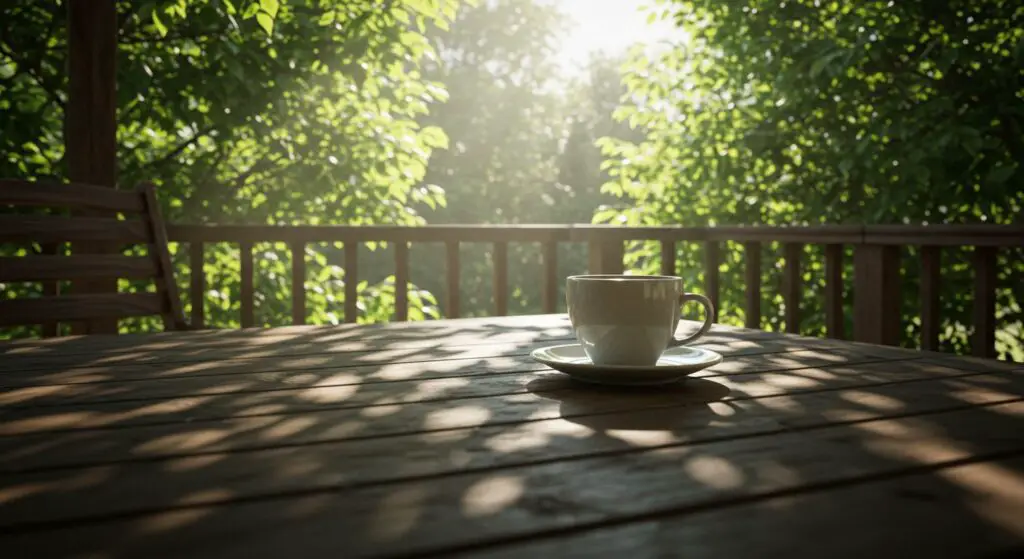
Creating this natural buffer is really important in modern landscape design. It’s not just about hiding. It’s about crafting a personal sanctuary. Your own little slice of peace right outside your door. A living screen transforms an ordinary yard into an intimate escape. It defines your space gently. And using plants helps your yard feel connected to the environment. It softens the edges of your property. It looks natural because it is natural. This approach adds beauty and ecological value, something a traditional fence just can’t do. It feels good to be surrounded by green, growing things.
So, how do you achieve this green seclusion without waiting years and years? The secret lies in choosing fast-growing shrubs. These aren’t your slow-poke plants. These shrubs mean business, putting on height and density quickly. They can dramatically change an exposed yard into a cozy, private haven much faster than many people realize. Prepare to discover the fantastic benefits these speedy shrubs bring. They offer more than just a visual block. We’ll cover essential tips for picking the perfect varieties for your specific needs and location. And you’ll get detailed profiles on some of the best, most reliable shrubs for creating that nearly instant privacy. We want you to feel confident making choices that will work beautifully in your outdoor space for years to come.
The Appeal of Fast-Growing Privacy Shrubs
Natural Screening Benefits
Think about a dense wall formed entirely of lush, green leaves. That’s the magic of using closely planted, fast-growing shrubs. They create an attractive, immediate feeling of seclusion. No more awkward eye contact over a low fence. No more needing to look at rundown sheds or overflowing recycling bins next door. A natural screening solution blocks these views with grace and style. These living walls bring texture, color, and life right to the edges of your garden. They feel so much softer and more inviting than rigid man-made structures like wood, metal, or vinyl fencing. The gentle rustling of leaves is much nicer than staring at bare boards. It’s about creating a backdrop that enhances your whole garden experience. Green is calming. It’s restful for the eyes.
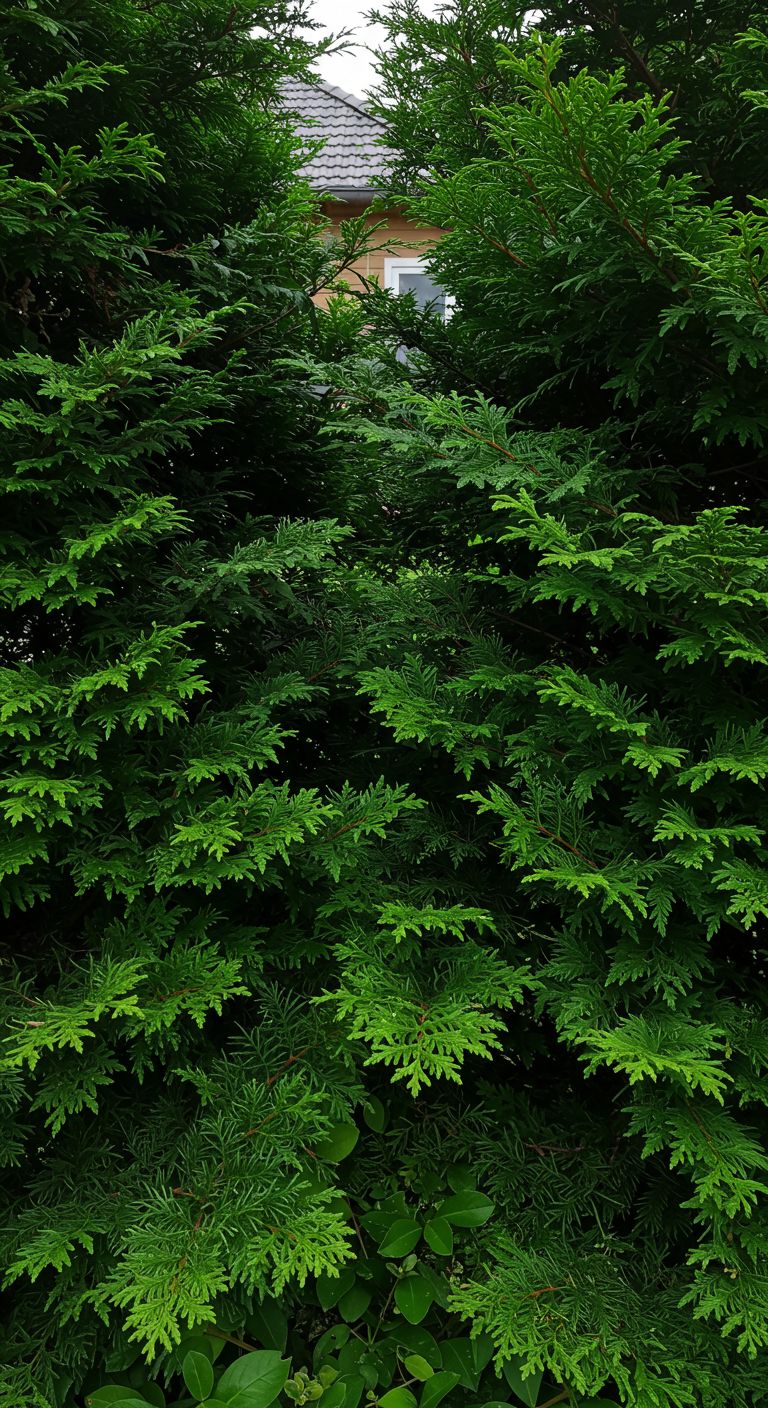
Beyond just blocking views outward, a green screen enhances the view from inside your home too. Imagine looking out your kitchen window to see a lovely frame of green instead of the side of your neighbor’s garage. Shrubs can strategically hide specific eyesores within your own yard too. Got an ugly air conditioning unit? A cluster of utility meters? A propane tank? Plant some attractive shrubs in front! They can cleverly conceal these functional but unattractive elements, making your entire yard feel more polished and serene. The visual appeal is undeniable and incredibly versatile.
Practical Advantages
But the beauty of these shrubs isn’t just leaf-deep. They offer significant practical pluses too. As mentioned, they quickly block unwanted sights. But their dense structure also works wonders for noise reduction. That constant drone from a nearby road? The neighbor’s weekend lawn mowing marathon? Shrub screens can help muffle those sounds. The leaves and branches absorb and deflect sound waves, creating a quieter, more peaceful atmosphere. It might not silence everything, but it can certainly take the edge off annoying background noise.
Think about windy days. A well-placed hedge can act as an effective windbreak. It can tame those breezes that make sitting on the patio uncomfortable or flatten delicate flowers in your garden beds. Creating calmer microclimates allows you to enjoy your outdoor space more often. It also protects other, less sturdy plants. And don’t forget the long-term value.
While plants require an initial investment and some care, they often cost less upfront than installing a quality fence. Over time, a healthy, mature hedge requires relatively little maintenance compared to fences that need painting, staining, or repairing rotted posts and broken panels. Plus, a beautiful, established landscape feature like a privacy hedge can even increase your property’s appeal to future buyers. They provide shade too, which can help cool the area slightly on hot days.
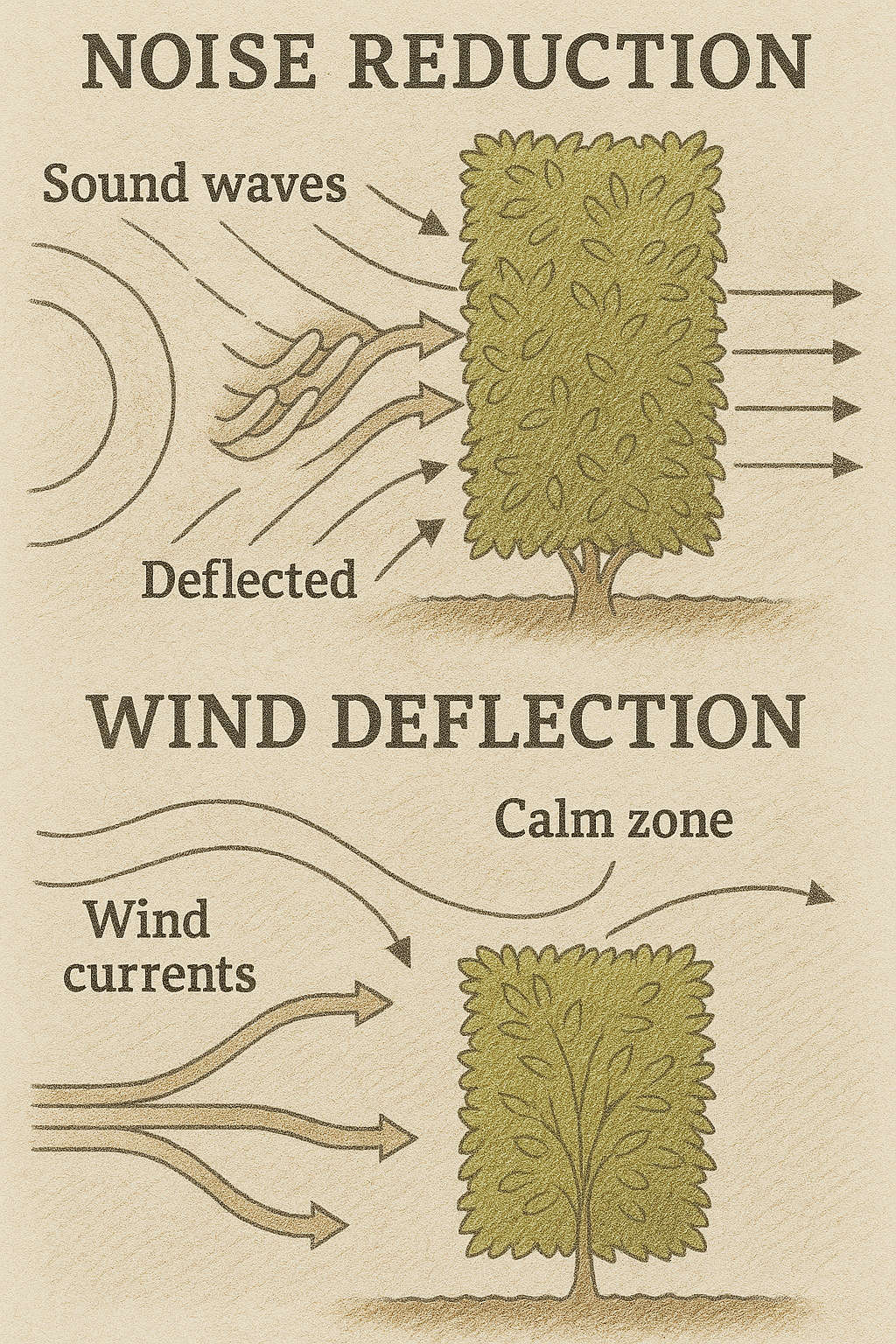
What We Need to Consider
Now, choosing the right shrub isn’t simply about finding the one labeled “fastest growing.” Success hinges on making an informed choice based on several factors. You absolutely need the right plant for your specific yard conditions. Understanding the growth rate and mature size is critical. You don’t want a shrub that shoots up quickly only to become a massive pruning nightmare later, or one that blocks your sunlight. Knowing its growth habit – whether it grows tall and narrow, or wide and bushy – is vital for proper spacing.
Consider the required maintenance. Are you someone who enjoys pruning, or do you prefer a plant that largely takes care of itself? Be honest about your commitment level. Some fast growers need regular trimming to stay neat and dense; others look best left more natural. And crucially, think about environmental suitability. Does the shrub match your soil type? Does it need full sun, or can it handle some shade? Is it hardy enough for your winter temperatures? We’ll help you navigate these considerations. Picking a shrub suited to your site ensures it will actually be fast-growing and thrive, giving you that beautiful living fence you’re dreaming of.
What Makes a Shrub Good for Privacy?
Choosing the right shrub involves looking at specific features. Not every tall plant makes a good screen. You need the right combination of traits for effective, attractive privacy. Let’s break down what to look for.

Density
Density is super important. Think thick! You want shrubs with lots of leaves and branches packed closely together. Ideally, this fullness should start right near the ground and go all the way up. Gaps defeat the purpose of a privacy screen. Some shrubs are naturally leggy, meaning they are bare at the bottom. Avoid those for screening. Dense foliage creates a solid visual barrier. It makes it much harder to see through the hedge. Look for plants described as having a “dense habit.”
Growth Rate
We’re talking fast-growing shrubs, right? But what does “fast” really mean? Generally, look for shrubs that can put on at least 2 feet of new growth per year. Some champions can even grow 3, 4, or even 5 feet annually under ideal conditions! Of course, this depends on the specific plant, your climate, soil, and how well you care for it. Faster growth means quicker privacy. You won’t have to wait ages for that secluded feeling. Just remember, super-fast growth often means more pruning later.
Mature Size Considerations
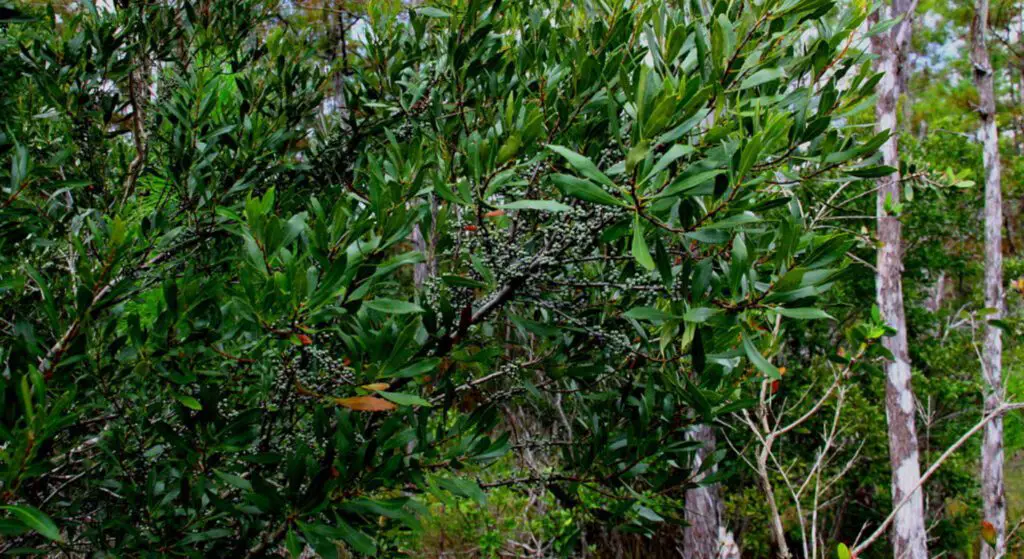
Pay close attention to the mature size listed on the plant tag. Understand both the potential height and width. A shrub might grow tall enough, but if it stays too narrow, you’ll need more plants placed closer together. Or it might grow wide enough but not tall enough. You need the right dimensions for your specific spot. Consider how big it will be in 5, 10, or even 20 years. Planning for the mature size prevents problems like overcrowding or blocking too much sun later on. Balance achieving coverage with avoiding future headaches.
Evergreen vs. Deciduous
Here’s a big choice: evergreen or deciduous? Evergreen shrubs keep their leaves all year round. Think pines, hollies, laurels. They provide constant, 12-month privacy. This is usually what people want for screening. Deciduous shrubs lose their leaves in the fall or winter. Think Forsythia or some Viburnums. They offer great coverage in spring and summer. But in winter, you’ll mostly see branches. Sometimes the branching is dense enough to offer partial screening. Deciduous options often provide seasonal interest like flowers or fall color. Choose based on whether you need year-round blockage or are okay with seasonal openness.
Maintenance Requirements
How much work are you willing to do? Some privacy shrubs need regular pruning to stay dense and tidy, especially formal hedges. Others look great left mostly alone, developing a more natural shape. Faster-growing shrubs usually need more frequent trimming to keep them in bounds. Slower growers need less work. Consider shearing versus selective pruning. Think about watering needs, potential pest issues, and fertilizing. Match the plant’s maintenance needs to your available time and energy. Be realistic about your gardening lifestyle.
Key Considerations Before Choosing Your Shrubs
Okay, you know what makes a good privacy shrub. But wait! Before you rush to the nursery, you need to assess your specific site. Planting the wrong shrub in the wrong place leads to disappointment. Healthy plants make the best screens. Let’s review the crucial factors for your yard.
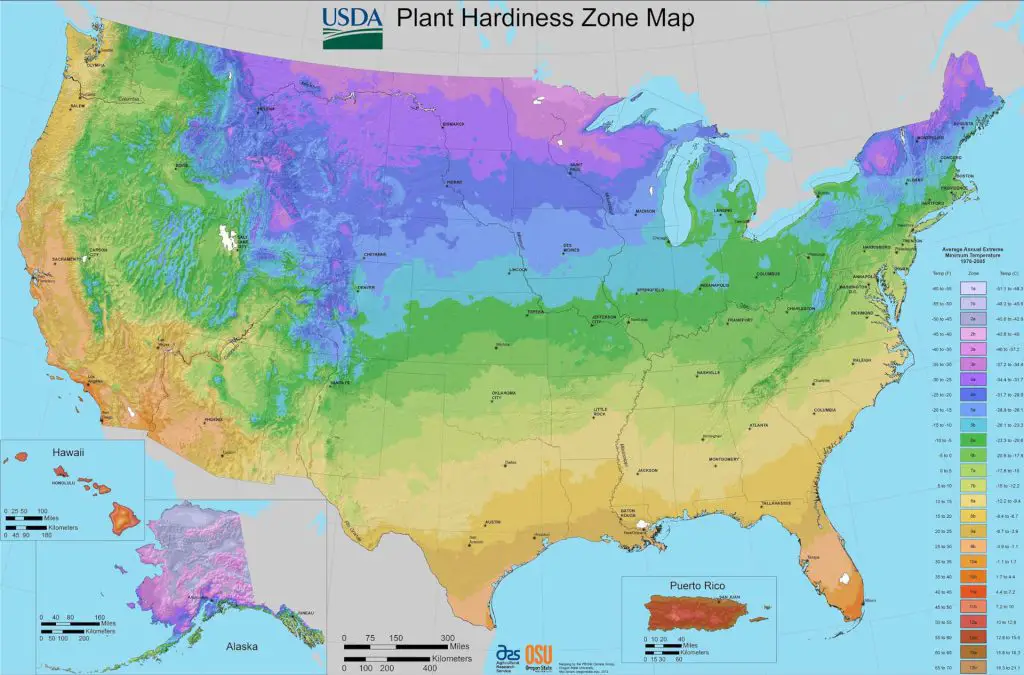
USDA Hardiness Zone
This is perhaps the most critical factor. The USDA Hardiness Zone map divides North America into zones based on average minimum winter temperatures. Plants are rated for the zones they can survive in. Planting something not suited for your zone means it might struggle or even die over winter. Find your zone! You can easily look it up online using your zip code. Nurseries usually label plants with their hardiness range (e.g., Zones 5-8). Always choose shrubs rated for your zone or colder. Don’t push it.
Sunlight Availability
Plants need sunlight to make food (photosynthesis). Different shrubs need different amounts. Carefully observe your planting area throughout the day. How many hours of direct sun does it actually receive? Full sun usually means 6 or more hours of direct sunlight. Part sun or part shade typically means 4 to 6 hours. Shade means less than 4 hours, or only dappled light. Be accurate. Planting a sun-lover in shade results in weak, sparse growth – not good for privacy! Match the shrub’s light needs to your site’s conditions.
Soil Type & Drainage
What kind of dirt do you have? Is it heavy clay that stays wet? Light, sandy soil that dries out fast? Or nice, crumbly loam? Most shrubs prefer well-drained soil. Meaning, water should soak in reasonably well, not sit around the roots. Poor drainage can lead to root rot, a common killer of plants. You can improve most soils by adding compost. Compost helps clay drain better and helps sand hold more water. Get a simple soil test if you’re unsure about your soil’s type or pH (acidity/alkalinity). Healthy soil supports strong growth.
Mature Size (Height and Width)
Yes, we mentioned mature size before, but it’s crucial for planning where to plant. Consider that ultimate height and width again. How far should you plant the shrubs from your house foundation? From driveways or sidewalks? From property lines? From each other? Planting too close to structures causes problems later. Planting shrubs too close together prevents good air circulation, which can encourage diseases. Always follow the spacing recommendations on the plant tag. Give them room to reach their full potential without creating a tangled mess. Proper spacing is key.
Maintenance Tolerance
Let’s revisit maintenance, but from your perspective. How much time and effort do you realistically want to spend trimming, watering, and caring for your hedge? If you love perfectly sheared, formal hedges, you’ll need fast-growing shrubs that tolerate frequent clipping, like Privet or Arborvitae. If you prefer a more natural, relaxed look and less work, choose shrubs that look good with minimal pruning. Match the plant’s needs to your willingness to provide care. An ignored high-maintenance shrub will not provide good privacy.
Invasive Potential
Be careful! Some plants that grow really fast can become bullies in the garden. Certain shrubs have invasive potential. This means they can spread aggressively, escaping your yard and crowding out native plants in natural areas. Privet and some types of Bamboo are common examples in certain regions. Always check if a plant you’re considering is listed as invasive in your specific state or county. Your local extension office or reputable nursery can provide this information. Choose responsibly. Avoid planting problems for yourself and the environment.
Fast-Growing Privacy Shrubs by Zone: Profiles and Recommendations
Choosing the right shrub means matching it to your climate zone and site conditions. Here are some popular fast-growers, broken down by where they thrive best. Remember to always double-check the specific USDA Hardiness Zone for any cultivar you buy.
A. Options Suitable for a Wide Range of Zones (Including Colder Areas)
These tough shrubs can handle colder winters found in many parts of the country. They are reliable choices for creating screens across diverse climates.
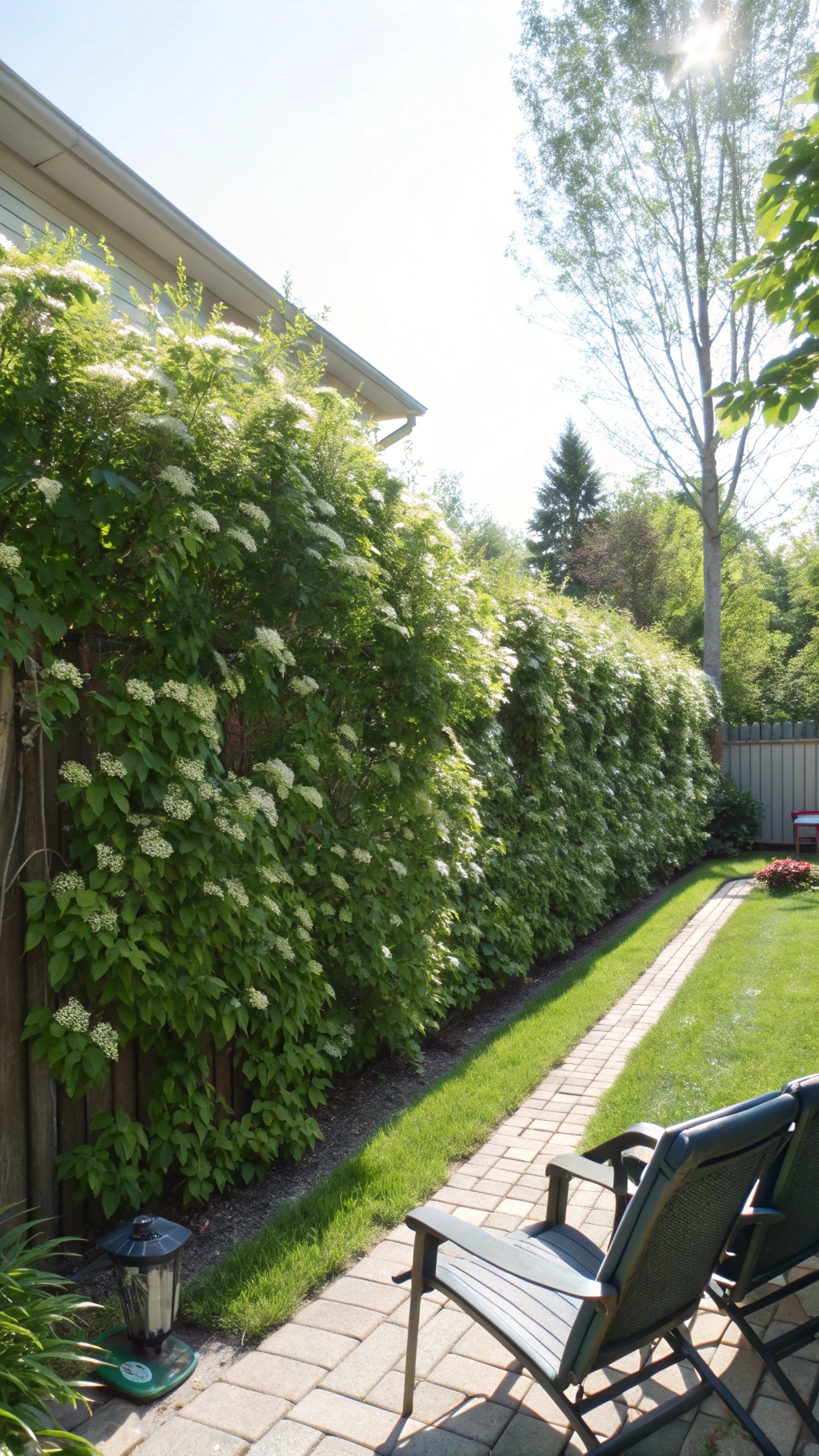
- Arborvitae ‘Green Giant’ (Thuja ‘Green Giant’)
This is a hugely popular privacy shrub for good reason. It grows incredibly fast, often 3 to 5 feet per year! Mature size is significant, reaching 40–60 feet tall and 12–18 feet wide. It forms a dense, rich green screen. It prefers full sun but tolerates part sun. Once established, maintenance involves moderate pruning mainly to control size if needed. Big advantages are its excellent density and deer usually leave it alone. But plan carefully; its large size can overwhelm smaller spaces if not given enough room. A real giant! - Arborvitae ‘Emerald Green’ (Thuja occidentalis ‘Smaragd’)
A more manageable cousin to ‘Green Giant’. Growth is slower, about 1 to 2 feet per year. It matures around 12–15 feet tall but only 3–4 feet wide. Perfect for narrower spaces or smaller yards. Like its big relative, it likes full sun and holds its bright emerald color well through winter. Very cold hardy. Creates a tidy, formal-looking hedge with minimal pruning needed to maintain its shape. Excellent density from top to bottom. A great choice where vertical screening is needed without excessive width. - Privet (Ligustrum species)
Privet grows very quickly, easily 2 to 3 feet per year. Depending on the type and your climate, it can be deciduous (loses leaves), semi-evergreen, or fully evergreen. It comes in various sizes. It tolerates heavy pruning and shearing, making it ideal for formal hedges. It’s adaptable to different soils and sun conditions. However, be very cautious. Many Privet species have high invasive potential in numerous regions. Check local regulations before planting. Some newer cultivars might be sterile, but always verify. - Arrowwood Viburnum (Viburnum dentatum)
This is a tough, adaptable deciduous shrub. It grows about 2 to 3 feet per year. It offers lovely white flowers in spring, blue-black fruit for birds later, and nice reddish fall color. Its branching structure is quite dense, providing decent screening even in winter after leaves drop. Tolerates various soils and sun exposures. Good choice for a more natural-looking screen. Provides seasonal interest that evergreen options lack. Remember, winter privacy will be reduced.
B. Recommendations for Moderate to Warmer Zones
These selections generally prefer milder winters but offer fantastic screening qualities where temperatures don’t plummet too severely.
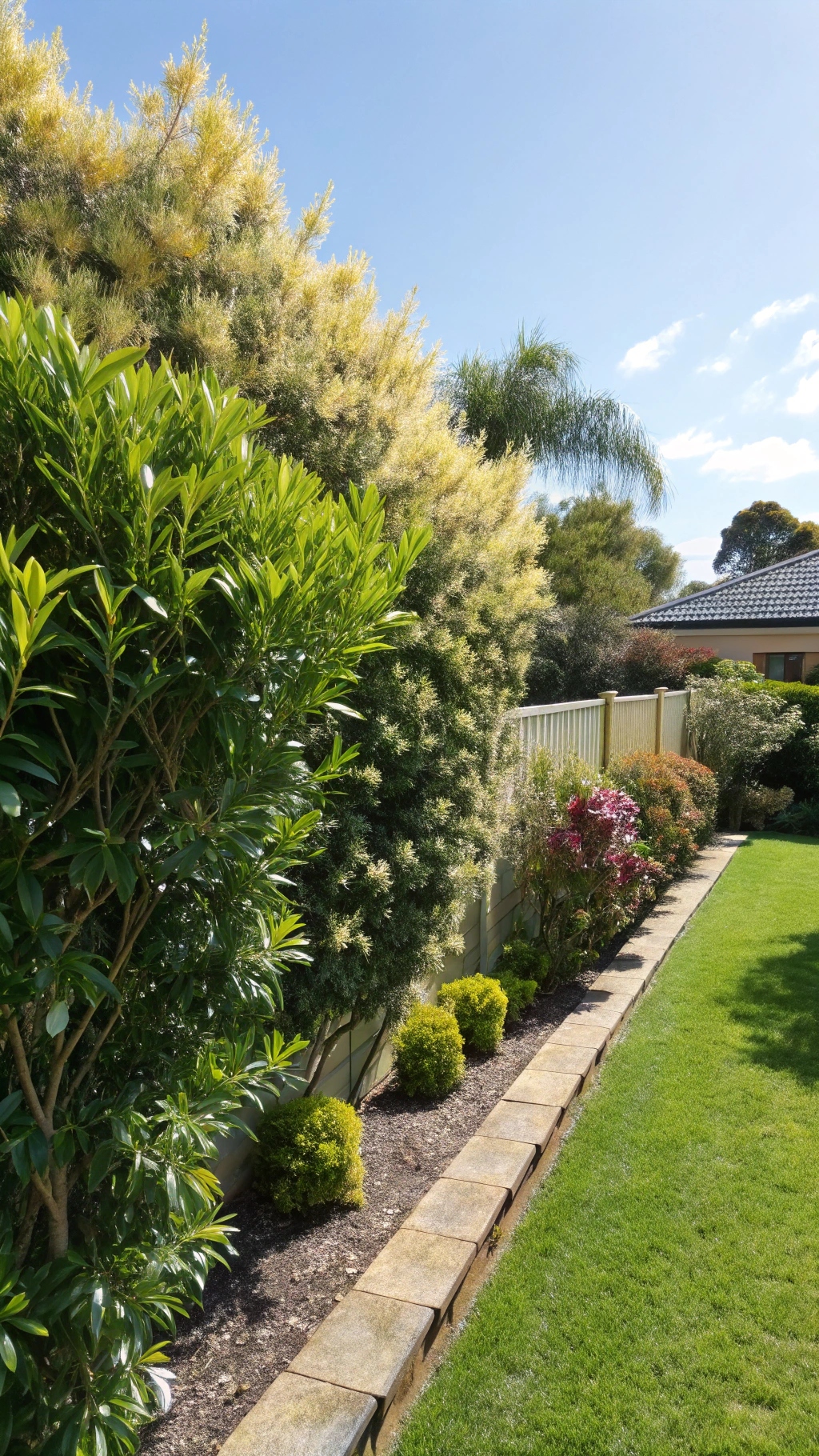
- Skip Laurel / Schipka Laurel (Prunus laurocerasus ‘Schipkaensis’)
Also called Schip Laurel. Known for its glossy, dark green evergreen leaves. It forms a dense hedge and grows quickly, about 2 to 3 feet annually. Mature size is typically 10-18 feet tall and 5-7 feet wide, though it takes pruning well. Tolerates shade better than many screen plants. Important notes: Requires good drainage to avoid root rot. Can be susceptible to shot hole disease (causes holes in leaves). All parts of the plant are toxic if eaten. - Cherry Laurel (Prunus laurocerasus)
Similar to Skip Laurel, Cherry Laurel offers fast growth (2–3 feet per year) and dense, evergreen foliage. Many cultivars exist, with varying mature sizes, some much larger than Skip Laurel. Tolerates shade and pruning. Needs well-drained soil. Shares the same potential issues with disease and toxicity as Skip Laurel. Great for creating lush, dark green backdrops. Requires attention to spacing to ensure good air circulation. - Leyland Cypress (x Cuprocyparis leylandii)
One of the fastest growers available! Expect 3 to 5 feet of growth per year in good conditions. Mature size is huge: 50–70 feet tall and 15–25 feet wide. Creates a very tall, dense screen quickly. However, it needs lots of space. Planting too close together often leads to disease problems (like canker and root rot) due to poor air circulation. Can suffer in extreme heat/humidity or drought. Prone to bagworms. Best for large properties where its massive size isn’t an issue. Requires significant commitment. - Wax Myrtle (Myrica cerifera / Morella cerifera)
A versatile evergreen (or semi-evergreen in colder parts of its range). Growth rate is fast, 2 to 4 feet per year. Mature size is often 10-20 feet tall and wide, but it responds well to pruning to control size. Very adaptable; tolerates drought, wet soils, sandy soils, and salt spray (good near coasts). Has pleasant smelling foliage. Can spread by suckers, forming thickets. Female plants produce waxy berries used for candle making. Caution: The foliage is flammable, so avoid planting too close to homes in fire-prone areas. - Nellie R. Stevens Holly (Ilex ‘Nellie R. Stevens’)
A beautiful, dense evergreen holly. Grows relatively fast for a holly, about 2 to 3 feet per year. Reaches 15–25 feet tall and 8–12 feet wide. Features classic glossy, dark green leaves (less prickly than some hollies) and abundant red berries in winter (needs a male pollinator nearby for best berry set, though often sets some fruit alone). Needs slightly acidic, well-drained soil. Prefers full sun to part sun. Makes a very attractive, upscale-looking screen. Good density provides excellent privacy. - Clumping Bamboo (Fargesia species)
Want the bamboo look without the invasion? Choose clumping bamboo. Unlike running types, its roots stay compact. It can shoot up to its mature height (which varies greatly by species, from 8 to 25+ feet) in just a few seasons. Provides a unique, tropical feel and the canes create great density. Crucial: Ensure you buy a true clumping variety (like Fargesia) suitable for your USDA Hardiness Zone. Requires consistent moisture and fertile soil. Excellent for narrow spaces where vertical screening is needed quickly.
C. Deciduous Options for Seasonal Privacy
If year-round screening isn’t essential, these fast-growing deciduous shrubs offer beauty and function during the growing season.
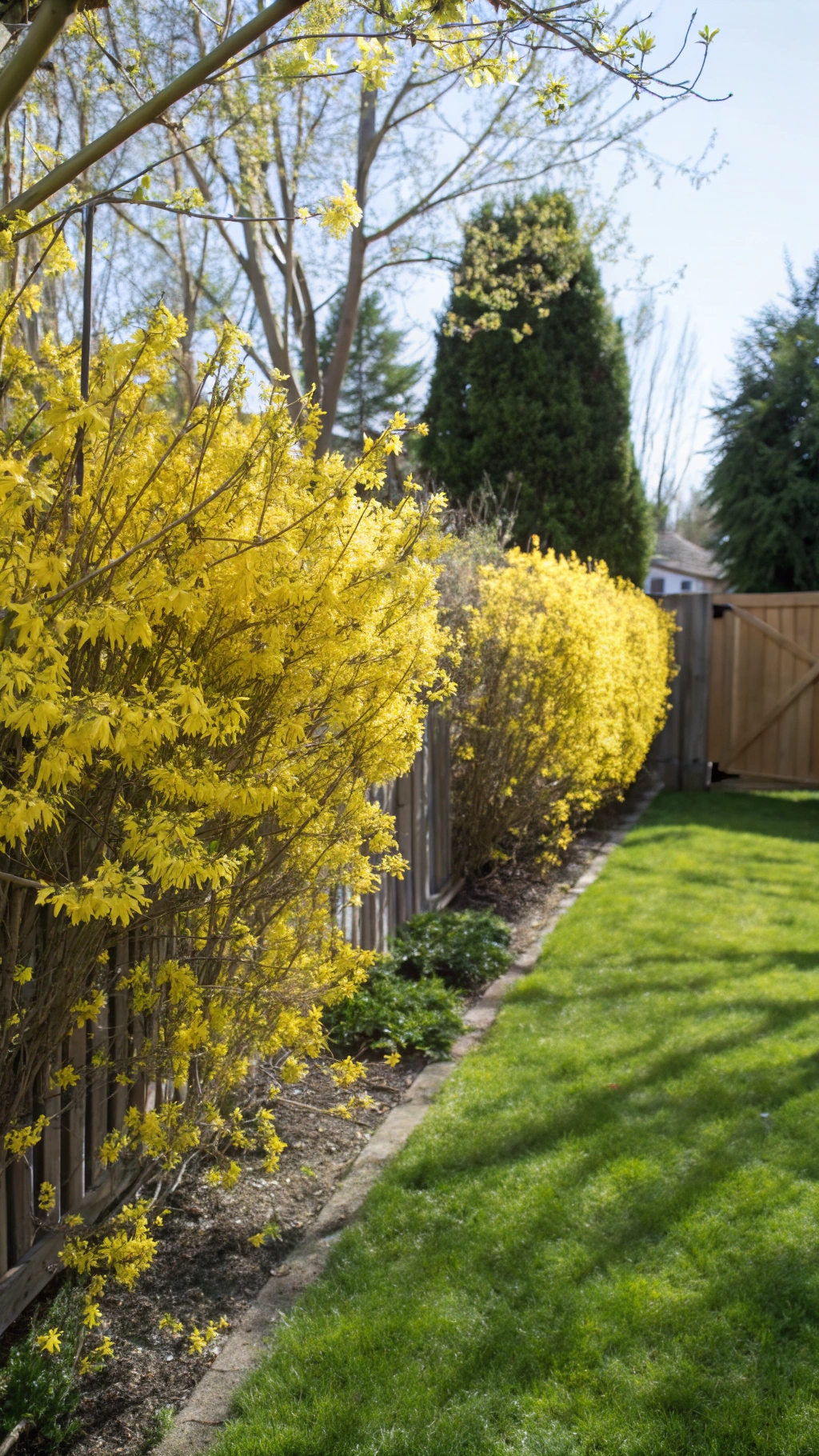
- Forsythia (Forsythia x intermedia)
Famous for its explosive burst of brilliant yellow flowers in early spring. Forsythia is a very fast grower, adding 2 to 4 feet per year. Forms a dense thicket of branches, offering good privacy during spring and summer when clothed in leaves. Mature size varies, often 8-10 feet tall and wide. Very tough and adaptable. Easy to grow. Needs full sun for best flowering. Main drawback: provides almost no visual screening in winter when branches are bare. Needs occasional pruning right after flowering to maintain shape and encourage blooms. - Certain Viburnums (e.g., Arrowwood Viburnum)
We mentioned Arrowwood Viburnum earlier, but many other deciduous Viburnums also grow quickly and offer dense summer screening. They often provide multiple seasons of interest: spring flowers, summer/fall fruit, and attractive fall color. Their branching structure can offer partial screening in winter. Check specific varieties for growth rate and mature size. Choose types known for dense habits if summer privacy is the main goal. A robust group with many options.
Planting and Care Strategies for Fast-Growing Hedges
You’ve picked your perfect fast-growing shrub! Now comes the important part: planting and caring for it correctly. Proper technique ensures your living fence establishes quickly and stays healthy for years.
Preparing the Area
Don’t just dig and drop. Good preparation sets the stage for success. Spend time on this step; your plants will thank you.
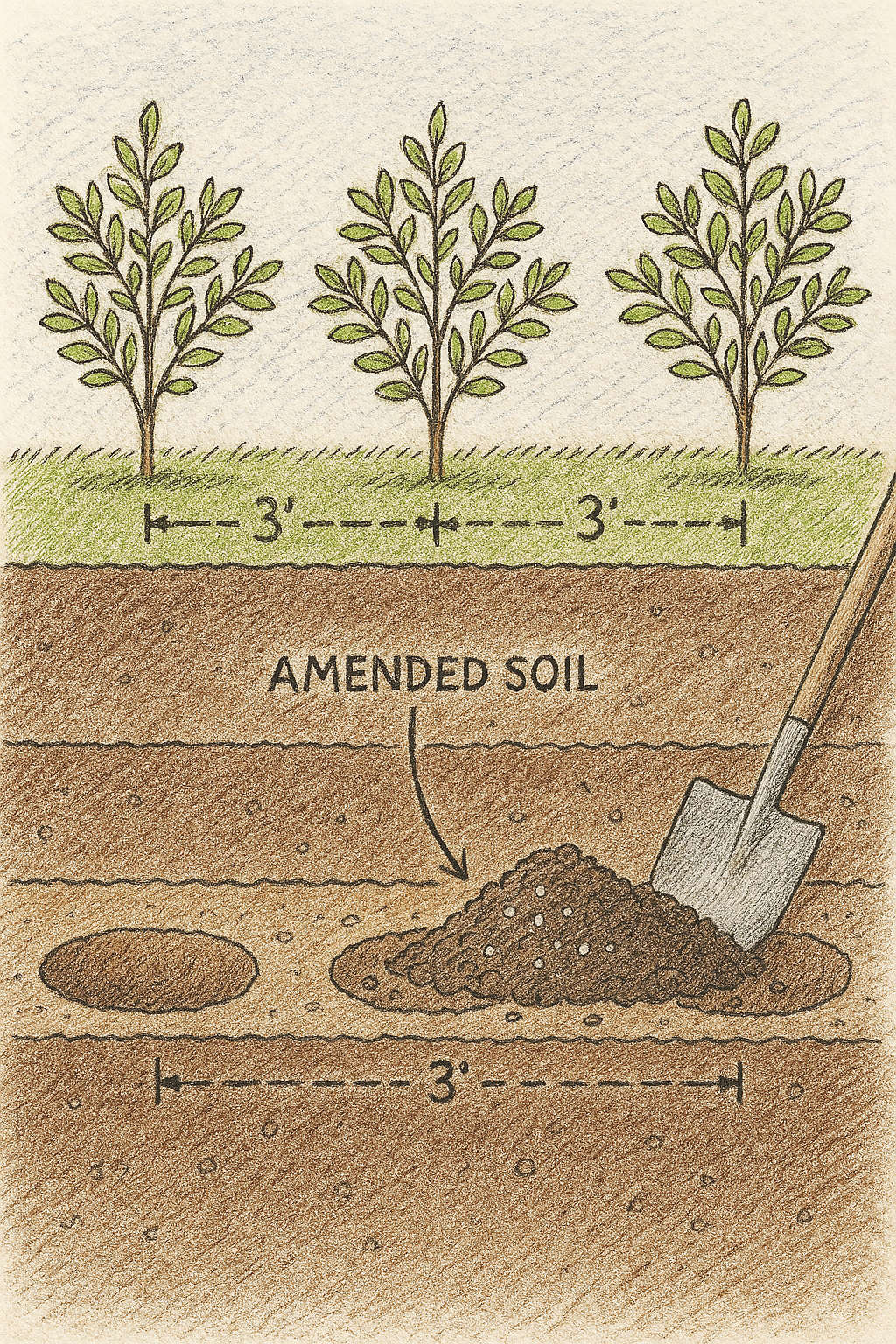
- Spacing Guidelines
Read the plant tag! It provides recommended spacing based on the shrub’s mature width. Measure carefully. Planting too close means overcrowding, poor air circulation, and increased disease risk later. Planting too far apart leaves gaps in your screen. Space them so the edges will just touch or slightly overlap when mature. Mark the spots before digging. Proper spacing is crucial for a healthy, dense hedge. - Soil Preparation
Good soil equals good growth. Most shrubs prefer well-drained soil rich in organic matter. Dig a trench or individual holes wider than you think you need – at least twice the width of the root ball. Loosen the soil on the sides of the hole too. Improve heavy clay or poor sandy soil by mixing in generous amounts of compost or other organic matter with the soil you removed. This improves drainage and fertility. Avoid adding fertilizer directly into the planting hole unless recommended for your specific plant.
Planting Techniques
How you place the plant in the ground matters. Follow these steps for a smooth transition from pot to soil.
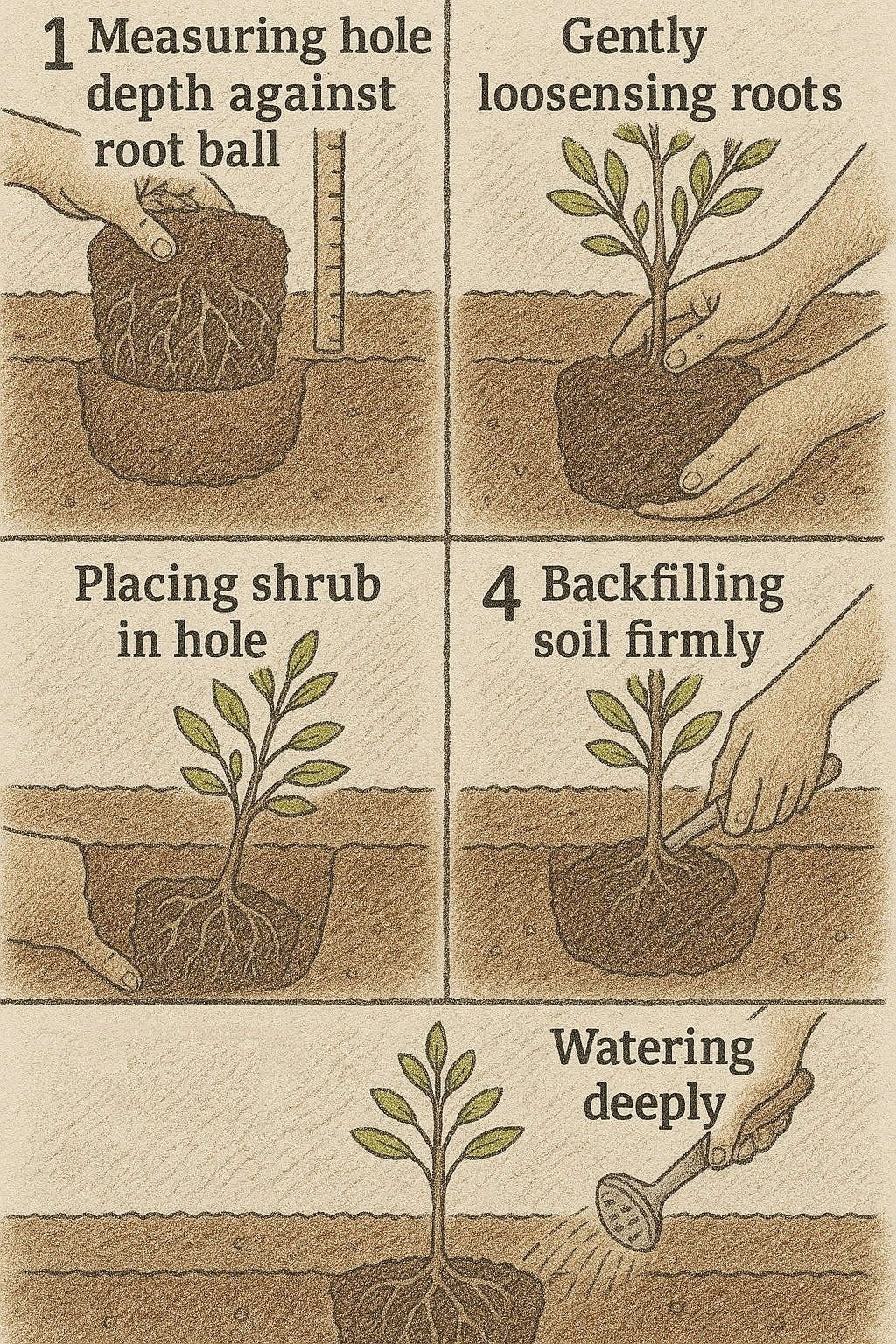
- Digging and Positioning
Dig the hole only as deep as the root ball. Planting too deep is a common mistake and can suffocate roots. Make the hole wide. Gently remove the shrub from its container. If roots are circling tightly (root-bound), gently tease them apart or make a few vertical cuts with clean pruners. Place the shrub in the center of the hole. Ensure the top of the root ball is level with or slightly above the surrounding ground level. Backfill the hole with the amended soil, gently firming it around the roots to remove large air pockets. Don’t stomp heavily. - Initial Watering
Watering immediately after planting is critical. Water deeply and thoroughly. Soak the entire root zone. This helps settle the soil around the roots and eliminates air pockets. Build a small berm or ring of soil around the edge of the planting hole to help hold water initially. Consistent watering during the first growing season (or two) is vital for establishing a strong root system. Don’t let the new plants dry out completely.
Ongoing Maintenance Practices
Your hedge is planted! Now keep it thriving with consistent care. Fast growers need attention to stay looking their best.
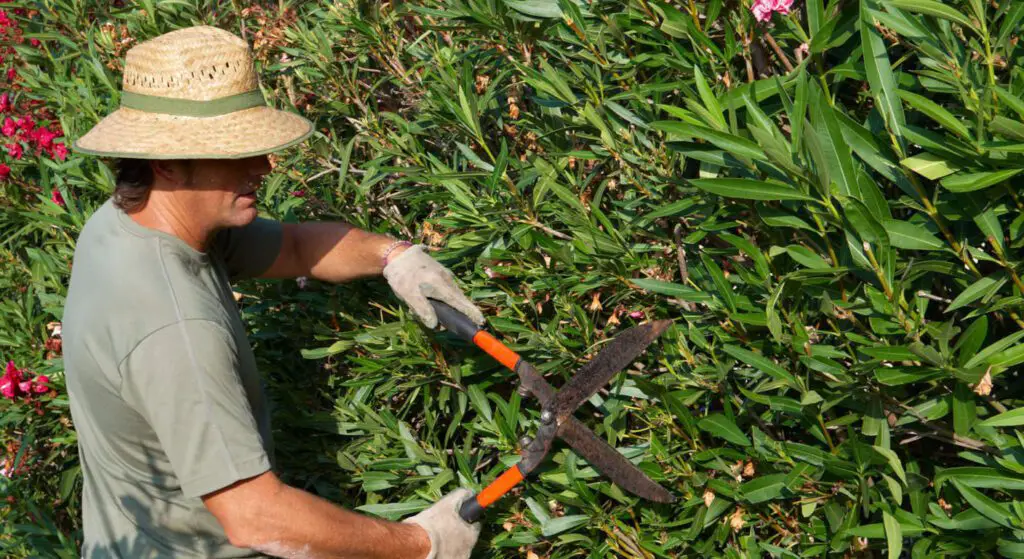
- Watering Protocols
Established shrubs need less frequent watering, but keep an eye on them, especially during hot, dry weather. Fast-growing plants often use more water. Water deeply when you do water, encouraging deep root growth. Soaker hoses or drip irrigation are efficient ways to water hedges. Check the soil moisture a few inches down before watering again. Needs vary by plant, soil, and climate. Adjust your schedule seasonally. - Mulching and Weed Control
Apply a 2–3 inch layer of organic mulch (like shredded bark, wood chips, or pine straw) around the base of your shrubs. Extend it out over the root zone. Mulch helps retain soil moisture, suppresses weeds that compete for water and nutrients, and keeps soil temperatures more even. Important: Keep the mulch pulled back an inch or two from the main stems or trunk. Piling mulch against the stems can cause rot. - Pruning and Shaping
Pruning is key for managing fast-growing hedges. Start shaping early. For formal hedges, shear lightly and often when plants are young to encourage dense branching low down. Always try to keep the top of the hedge slightly narrower than the bottom. This allows sunlight to reach the lower branches, preventing that bare-bottom look. For informal hedges, selective pruning to remove wayward branches or control size may be all that’s needed. Prune at the right time of year for your specific shrub (e.g., after flowering for spring bloomers). - Addressing Common Challenges
Fast growth can sometimes lead to legginess or sparse areas. Regular light pruning often helps encourage density. Ensure good air circulation by maintaining proper spacing and occasionally thinning out thick growth if needed. Monitor for pests or diseases. Healthy, well-cared-for plants are less susceptible. Address problems quickly if they arise. Fertilize lightly in spring if needed, based on soil test results or plant appearance. Avoid over-fertilizing, which can force weak growth.
Expert Advice and Final Considerations
You’re almost ready to start planting! But before you do, let’s cover a few more points. Thinking ahead and using available resources can make a big difference in your long-term success and happiness with your living privacy screen.
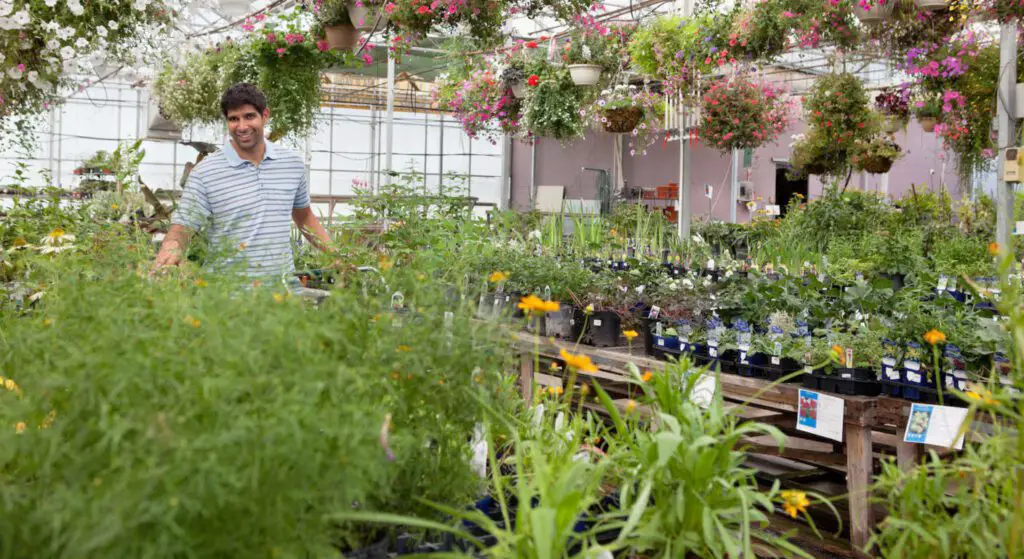
Consulting Local Experts
Reading articles like this is a great start. But sometimes you need personalized advice. Who knows your area best? The folks at good local nurseries. They deal with plants that succeed in your specific climate and soil every single day. Don’t be shy! Ask them questions. Show them pictures of your planting area. They understand regional quirks – maybe a certain pest is common nearby, or a specific cultivar does unusually well where you live. Their insights can save you time, money, and heartache. Use their knowledge!
Long-Term Planning for Your Garden
Remember that fast-growing shrubs become big shrubs. Think about the future. Visualize how that mature size and density will fit into your overall garden design years down the road. Will that giant Arborvitae eventually block too much sun from your vegetable patch? Will the roots interfere with a pathway? Long-term planning helps avoid these issues. Balance your desire for quick screening now with the reality of managing larger plants later. Maintenance needs might change as the hedge matures. Be prepared to adapt.
Practical Tips for Sustained Privacy
Keeping your natural fence looking good involves ongoing attention. Adjust your care routines with the seasons. Plants need different amounts of water in summer versus fall. Pruning times vary. Fertilizing is usually best done in spring. Learn to recognize signs of stress. Are leaves yellowing? Are there spots or pests? Addressing issues early keeps your screen healthy and dense. And why not share what you learn? Talk to neighbors, join a garden club, or find online groups. Community engagement around gardening is fun. Sharing tips and experiences helps everyone grow better gardens.
Final Thoughts
You’ve learned a lot about creating privacy with fast-growing shrubs! From understanding the importance of density and growth rate to selecting plants suited for your USDA Hardiness Zone and specific site conditions, you have the foundation you need.

We saw that effective natural screening comes from thick foliage and quick growth. We learned choosing the right shrub involves matching its needs (sun, soil, water) and characteristics (size, evergreen vs. deciduous, maintenance) to your yard and lifestyle. Preparation and proper planting are key first steps. Ongoing care keeps your living fence thriving. It’s all connected!
Final Recommendations
So, what now? Visit those local nurseries. Talk to the experts. Touch the leaves, compare the growth habits. Choose shrubs that genuinely fit your space and commitment level. Think about the lasting value. A beautiful, healthy hedge offers years of enjoyment, reduced noise, and that wonderful feeling of seclusion. It enhances your home.
Next Step
Don’t just dream about a private backyard oasis. Start planning it today! Use the knowledge you’ve gained here. Select your shrubs with confidence. Prepare your soil with care. Plant them properly. Imagine yourself enjoying your transformed outdoor space sooner than you think. Your choices create not just immediate privacy, but also add enduring beauty and life to your landscape. Go ahead, grow your own fence!
